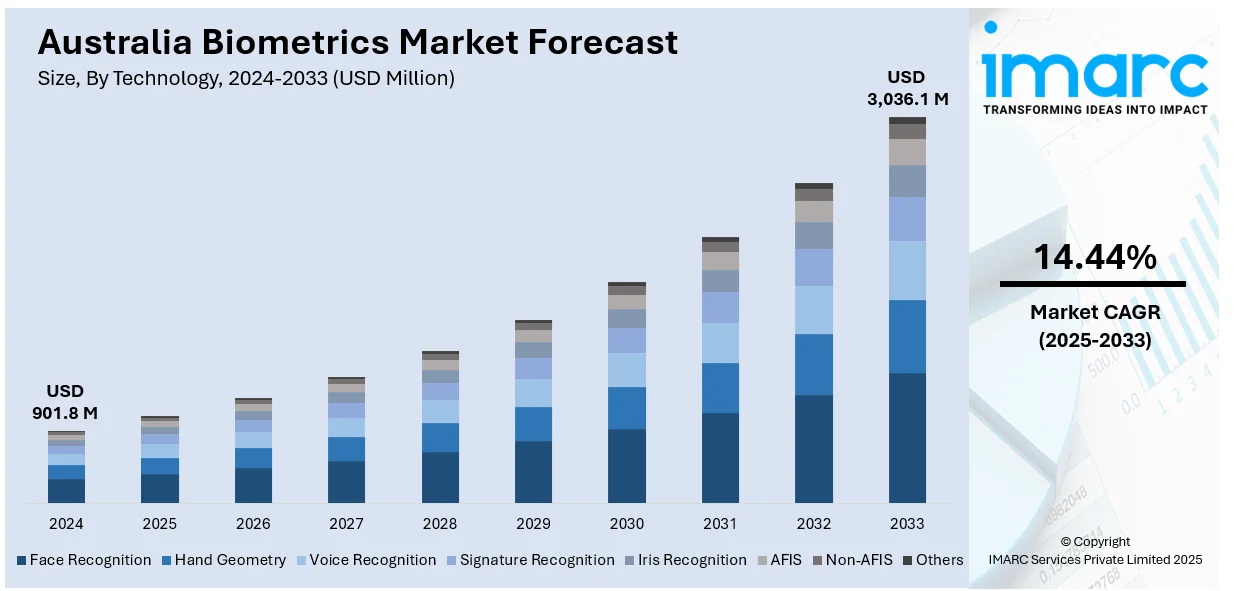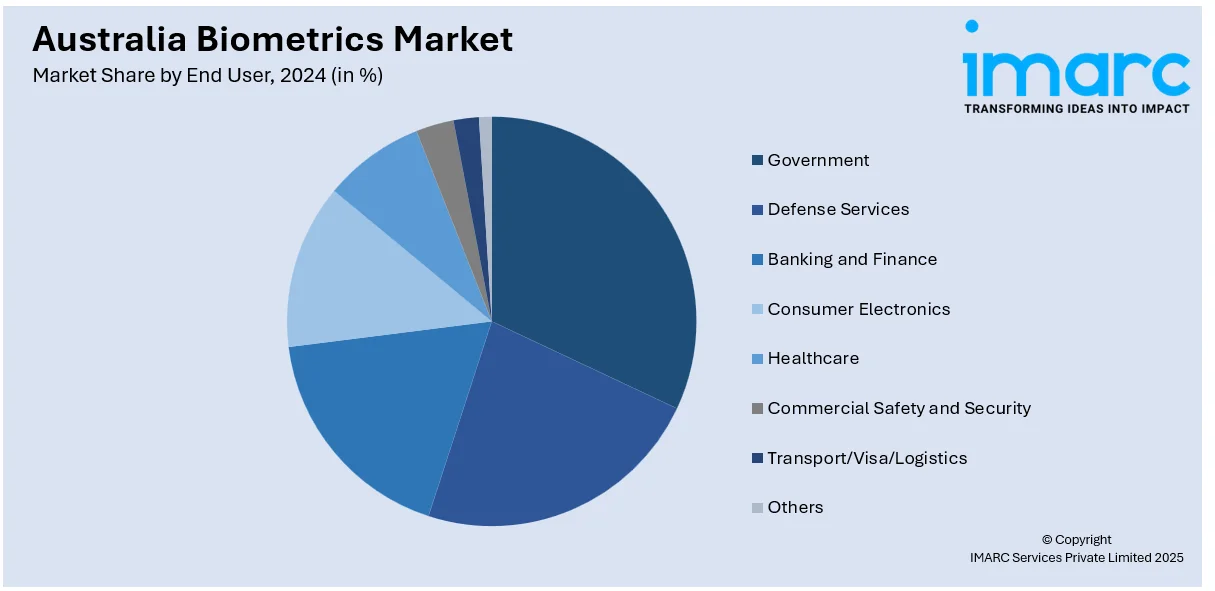
Australia Biometrics Market Size, Share, Trends and Forecast by Technology, Functionality, Component, Authentication, End User, and Region, 2025-2033
Australia Biometrics Market Overview:
The Australia biometrics market size reached USD 901.8 Million in 2024. Looking forward, IMARC Group expects the market to reach USD 3,036.1 Million by 2033, exhibiting a growth rate (CAGR) of 14.44% during 2025-2033. The market is growing due to rising demand for secure digital identity verification in banking, government, and healthcare sectors. Key drivers include increasing cyber threats, regulatory support for data security, and the need for seamless authentication in fintech and border control. Technological advancements and government investments are further augmenting the Australia biometrics market share.
|
Report Attribute
|
Key Statistics
|
|---|---|
|
Base Year
|
2024 |
|
Forecast Years
|
2025-2033
|
|
Historical Years
|
2019-2024
|
| Market Size in 2024 | USD 901.8 Million |
| Market Forecast in 2033 | USD 3,036.1 Million |
| Market Growth Rate 2025-2033 | 14.44% |
Australia Biometrics Market Trends:
Increasing Adoption of Biometrics in Banking and Financial Services
The growing banking and financial services sector’s push toward enhanced security and seamless customer experiences is significantly supporting the Australia biometrics market share. The financial sector is increasingly leveraging fingerprint, facial, and voice recognition as a means to combat fraud, streamline identity verification, and execute contactless payments. This trend has been significantly accelerated by the rise of digital banking and mobile payment systems, causing major Australian banks to adopt biometric authentication instead of traditional passwords or PIN numbers. A research report from the IMARC Group indicates that the digital payment market in Australia was valued at USD 118.0 Billion in 2024. It is projected to grow to USD 667.0 Billion by 2033, reflecting a compound annual growth rate (CAGR) of 20.89% from 2025 to 2033. Regulatory measures also serve as a tool for the adoption of safe digital identity solutions. With the growing threat of cyber-attacks, these biometric technologies offer a strong defense against identity theft, which makes them an ideal candidate for secure transactions. This trend is only forecasted to grow as more and more fintech startups and established banks are pouring investment dollars into more advanced biometric systems that can keep up with the consumer demand for security and convenience.

To get more information on this market, Request Sample
Government Initiatives Driving Biometric Use in Border Control and Public Security
The Australian government is increasingly leveraging biometric technologies to strengthen border security and public safety, creating a positive Australia biometrics market outlook. Programs such as the “SmartGate” system used for airport check-ins use facial recognition technology to expedite the passenger processing process while upholding rigorous security measures. The Department of Home Affairs has been expanding its biometric capabilities, such as fingerprint and iris scanning, as well as identity verification for visas and immigration. On the other hand, biometric technologies are increasingly used by different law enforcement agencies to recognize and track criminals, according to AI-powered analytics. These measures are consistent with international security trends and demonstrate Australia’s commitment to counterterrorism and combating cybercrime. Australia witnessed 47 million data breaches in 2024, equating to one breach every second, ranking it as the 11th most affected country globally. Thus, the breach density was 1,785 incidents per 1,000 residents. This rise in cybercrime is highlighting the need for stronger data governance and privacy practices to protect sensitive financial information. As public-private partnerships increase, biometric solutions will increasingly become part of national security systems, fueling market growth. The trend reflects the government's emphasis on technology-based security initiatives, guaranteeing sustained growth in the biometrics market.
Australia Biometrics Market Segmentation:
IMARC Group provides an analysis of the key trends in each segment of the market, along with forecasts at the country level for 2025-2033. Our report has categorized the market based on technology, functionality, component, authentication, and end user.
Technology Insights:
- Face Recognition
- Hand Geometry
- Voice Recognition
- Signature Recognition
- Iris Recognition
- AFIS
- Non-AFIS
- Others
The report has provided a detailed breakup and analysis of the market based on the technology. This includes face recognition, hand geometry, voice recognition, signature recognition, iris recognition, AFIS, non-AFIS, and others.
Functionality Insights:
- Contact
- Non-contact
- Combined
A detailed breakup and analysis of the market based on the functionality have also been provided in the report. This includes contact, non-contact, and combined.
Component Insights:
- Hardware
- Software
The report has provided a detailed breakup and analysis of the market based on the component. This includes hardware and software.
Authentication Insights:
- Single-Factor Authentication
- Multifactor Authentication
A detailed breakup and analysis of the market based on the authentication have also been provided in the report. This includes single-factor authentication and multifactor authentication.
End User Insights:

- Government
- Defense Services
- Banking and Finance
- Consumer Electronics
- Healthcare
- Commercial Safety and Security
- Transport/Visa/Logistics
- Others
The report has provided a detailed breakup and analysis of the market based on the end user. This includes government, defense services, banking and finance, consumer electronics, healthcare, commercial safety and security, transport/visa/logistics, and others.
Regional Insights:
- Australia Capital Territory & New South Wales
- Victoria & Tasmania
- Queensland
- Northern Territory & Southern Australia
- Western Australia
The report has also provided a comprehensive analysis of all the major regional markets, which include Australia Capital Territory & New South Wales, Victoria & Tasmania, Queensland, Northern Territory & Southern Australia, and Western Australia.
Competitive Landscape:
The market research report has also provided a comprehensive analysis of the competitive landscape. Competitive analysis such as market structure, key player positioning, top winning strategies, competitive dashboard, and company evaluation quadrant has been covered in the report. Also, detailed profiles of all major companies have been provided.
Australia Biometrics Market News:
- October 04, 2024: VFS Global announced establishing 23 biometric collection centers across 13 countries in Sub-Saharan Africa and Europe by February 2025 under its exclusive partnership with the Australian Department of Home Affairs. It will offer services such as biometric data collection, identity verification, aid in submitting digital applications and remote support for applicants for Australian visas. This initiative significantly bolsters Australia’s biometric capabilities overseas and further establishes VFS Global as the global operator of biometric services for Australian visa applications.
- April 23, 2024: Waave launched its Waave Wallet, a biometrically protected account, in Australia, allowing instant account-to-account transactions via its Pay by Bank service integrated with the New Payments Platform. The Wallet uses fingerprint and Face ID authentication, increasing Open Banking security to combat rising fraud threats and lowering the USD 3 Billion that merchants annually pay in fees. This launch aligns with Waave's recognition as the recipient of the 2024 Canstar Innovation Excellence Award for its innovative, secure, card-free payment solution.
Australia Biometrics Market Report Coverage:
| Report Features | Details |
|---|---|
| Base Year of the Analysis | 2024 |
| Historical Period | 2019-2024 |
| Forecast Period | 2025-2033 |
| Units | Million USD |
| Scope of the Report |
Exploration of Historical Trends and Market Outlook, Industry Catalysts and Challenges, Segment-Wise Historical and Future Market Assessment:
|
| Technologies Covered | Face Recognition, Hand Geometry, Voice Recognition, Signature Recognition, Iris Recognition, AFIS, Non-AFIS, Others |
| Functionalities Covered | Contact, Non-Contact, Combined |
| Components Covered | Hardware, Software |
| Authentications Covered | Single-Factor Authentication, Multifactor Authentication |
| End Users Covered | Government, Defense Services, Banking and Finance, Consumer Electronics, Healthcare, Commercial Safety and Security, Transport/Visa/Logistics, Others |
| Regions Covered | Australia Capital Territory & New South Wales, Victoria & Tasmania, Queensland, Northern Territory & Southern Australia, Western Australia |
| Customization Scope | 10% Free Customization |
| Post-Sale Analyst Support | 10-12 Weeks |
| Delivery Format | PDF and Excel through Email (We can also provide the editable version of the report in PPT/Word format on special request) |
Key Questions Answered in This Report:
- How has the Australia biometrics market performed so far and how will it perform in the coming years?
- What is the breakup of the Australia biometrics market on the basis of technology?
- What is the breakup of the Australia biometrics market on the basis of functionality?
- What is the breakup of the Australia biometrics market on the basis of component?
- What is the breakup of the Australia biometrics market on the basis of authentication?
- What is the breakup of the Australia biometrics market on the basis of end user?
- What is the breakup of the Australia biometrics market on the basis of region?
- What are the various stages in the value chain of the Australia biometrics market?
- What are the key driving factors and challenges in the Australia biometrics market?
- What is the structure of the Australia biometrics market and who are the key players?
- What is the degree of competition in the Australia biometrics market?
Key Benefits for Stakeholders:
- IMARC’s industry report offers a comprehensive quantitative analysis of various market segments, historical and current market trends, market forecasts, and dynamics of the Australia biometrics market from 2019-2033.
- The research report provides the latest information on the market drivers, challenges, and opportunities in the Australia biometrics market.
- Porter's five forces analysis assist stakeholders in assessing the impact of new entrants, competitive rivalry, supplier power, buyer power, and the threat of substitution. It helps stakeholders to analyze the level of competition within the Australia biometrics industry and its attractiveness.
- Competitive landscape allows stakeholders to understand their competitive environment and provides an insight into the current positions of key players in the market.
Need more help?
- Speak to our experienced analysts for insights on the current market scenarios.
- Include additional segments and countries to customize the report as per your requirement.
- Gain an unparalleled competitive advantage in your domain by understanding how to utilize the report and positively impacting your operations and revenue.
- For further assistance, please connect with our analysts.
 Request Customization
Request Customization
 Speak to an Analyst
Speak to an Analyst
 Request Brochure
Request Brochure
 Inquire Before Buying
Inquire Before Buying




.webp)




.webp)












